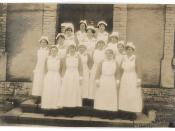Child-rearing was an evolving practice within the English upper class from the sixteenth through eighteenth centuries. A new adult view of children as mature, fragile and inherently good led to changes in the nursing, care, and discipline of English, aristocratic children.
In the 16th century, much in accordance with the Puritan doctrine, children were seen as naturally evil beings (Doc 1). Proper and pious parents were responsible for instilling virtues and morals into their organically pagan children. However, the Stuart-run religious beliefs of the 17th century and the Anglican Church brought about a new and differing view of children. Offspring were effectively blank-slates and, left to their own devices, happy and benevolent (Doc 2, 3). The new society placed more blame on nurture, rather that nature, and these views led to drastic changes in how children were reared.
In the 1500s and early 1600s, aristocratic mothers often hired, after giving birth, a wet nurse, a woman whose job it was to breast-feed the infant.
Women craved separation from ungodly children, and felt the duty of breastfeeding was disgraceful. However, many mothers now saw the hiring of wet nurses morally reprehensible (Doc 5). In the late 17th and 18th centuries, parents now craved a closeness and bond with their children, often enhanced by breastfeeding (Doc 6, 7). Children and infants had garnered a better reputation, an parents now sought close and loving relationships with them (Doc 4).
Furthermore, scientific changes brought a new adult view of child-rearing. Doctors now sought to care for an infant with a more tender and loving touch, and sought less to control it. In the 1500s, mothers often constricted the motion of their newborn by swaddling it tightly (Doc 8). New medical developments attributed fractures to this practice, and by the 1700s, it was long since...


